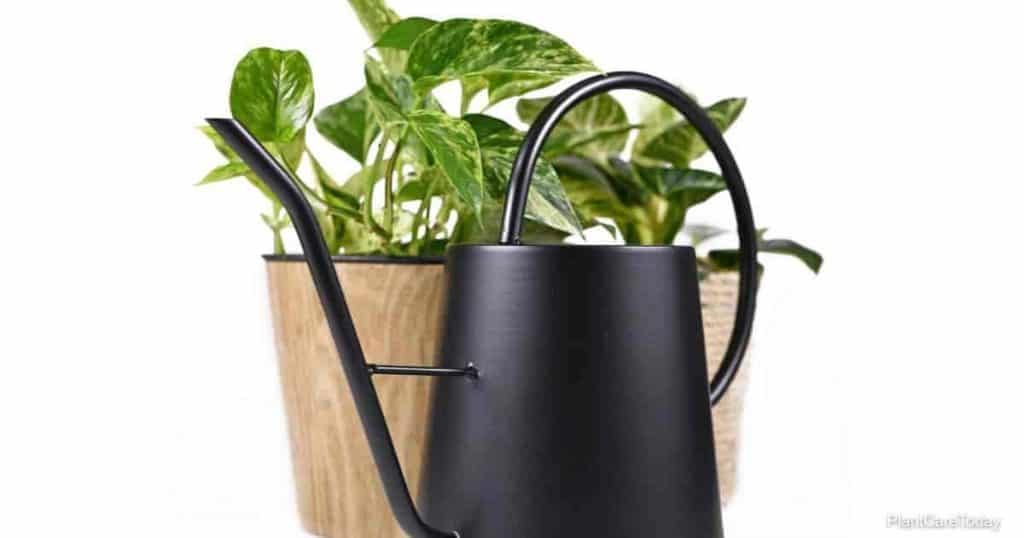Pothos is one of the most popular houseplants alongside Philodendron. The pothos plant is durable and easy to grow.
Scientifically referred to as Epipremnum, pothos plants are a staple of homes and offices, but are also found growing outdoors in USDA hardiness zones 10 to 11.

While these plants known also as devil’s ivy generally require the same amount of light and water, their appearance may vary greatly.
A few of the more popular pothos varieties you may wish to adopt are:
- Golden pothos (AKA devils ivy) – pothos vines with variegated yellow leaves
- Jade pothos – cultivar with dark green leaves and gold variegation
- Marble queen pothos – green and white “marbled” leaves
- Neon pothos – known for the bright green foliage
How Often Should You Water Pothos?
While the particular watering needs of pothos plants are similar to that of other houseplants, there are a number of factors to consider if you want to provide the optimum amount.
You can apply a basic indoor plant care approach successfully, but following a more precise approach to pothos plant care will result in a much healthier plant.
- Water when the soil is dry down to 1” inch from the surface.
- Water thoroughly to ensure the entire root ball receives water.
- Drain off any excess water to prevent standing water.
Factors To Consider In Pothos Watering
There are a wide range of factors involved in properly calculating the amount of water your pothos will need in its current environment.
Light Conditions and Humidity
Having enough light can affect the quantity and how often you need to water a pothos.
Outdoors, pothos does well in low light conditions, but inside a pothos plant prefers bright indirect light.
Exposing the plant to direct sunlight will allow the soil to dry out faster. Leaves may sunburn if they are damp. Lower light may result in the plant drinking less frequently.
Likewise, pothos prefers higher humidity. Low humidity conditions will result in more frequent waterings.
Pot Size and Soil Quality
Not all soils are created equal, and the composition of your potting mix can have a lot to do with how much and how often your pothos plant needs to be watered.
Pothos needs a well-draining soil mix, which may be either store bought or mixed at home by adding perlite or similar aggregate material, supplemented by a good houseplant fertilizer.
Related: The Best Pothos Fertilizer
You will also want to use pots or hanging baskets with good drainage holes on the bottom.
When the root system becomes too cramped, repotting in a new container two sizes larger is necessary or the plant will be unable to get enough water no matter how much you give it.
Root Size
Pothos has a relatively small root ball, so it can take a while for it to drink all of the water you provide.
Oversaturating the soil will generally result in the roots being exposed to standing water, which in turn will cause root rot.
Related: Pothos Root Rot Causes and Prevention
Water Quality
The more pure your water supply, the healthier your pothos will be.
Distilled water is the best, followed by rainwater and filtered water.
It is also a good idea to use a mix of 2 teaspoons of 35% percent hydrogen peroxide per gallon of water.
This simulates the qualities of natural rainwater and assists in both plant growth and pest/disease control.
Why the Saturation Method Works
All of these warnings about too much water can make it sound like poor plant care to saturate your pothos’s pot.
But, one of the biggest mistakes a pothos owner can make on their indoor plants is to water enough to only supply the top of the root ball.
When done properly, saturation will provide the entire root system with water without creating standing water.
- Ensure your pothos is in a container two inches larger than the root ball, with adequate drainage holes.
- Make sure the potting soil you use is porous and drains well.
- Pour the water carefully around the base of the plant, avoiding any water on the leaves, until water begins coming out of the drainage holes.
- Gently tip the pot to pour off any standing water from the surface.
- Allow the soil to become completely dry down to at least 1” inch from the surface before watering again.
Watering from the bottom is also a good watering method.
Overwatering and Underwatering
Signs of Overwatering
- Too much water will lead to rotting roots, potentially killing the plant.
- Mealybugs on Pothos are also a common sign of overwatering.
Check out: How To Save And Care For An Overwatered Pothos
Signs of Underwatering
Wilting leaves are one of the most common signs of a dehydrated plant, and the normally green leaves will become mixed with brown or bright yellow leaves.
The leaves will begin to droop, which may also be a sign the plant has outgrown its container.